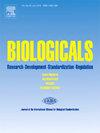The impact of LPS mutants on endotoxin masking in different detection systems
IF 1.5
4区 生物学
Q4 BIOCHEMICAL RESEARCH METHODS
引用次数: 0
Abstract
Endotoxin masking poses a potential risk to patient safety by rendering endotoxin undetectable. While research often focuses on international endotoxin standards (RSE), the effects of LPS mutants on Low Endotoxin Recovery (LER) are poorly understood. Our study investigated S. minnesota and E. coli mutants with incomplete O-antigen chains (rough LPS) using Limulus amebocyte lysate (LAL), recombinant Factor C (rFC) and the monocyte activation test (MAT). All tested methods detected the mutants, with variations in activity observed. Measurements over time in a common drug formulation (10 mM sodium citrate and 0.05 % (w/v) polysorbate 20) showed different masking kinetics for the mutants using different methods. We were able to show that LAL and rFC have comparable kinetics, whereas MAT showed improved recovery of masked endotoxin. The study showed that the mutation of LPS have an effect on masking, independent of the assay system. We propose that polysaccharide length affects masking susceptibility, with lower hydrophilic/hydrophobic ratios caused by the shortened polysaccharide chain (rough LPS) reducing masking. In addition, the stronger negative charge of the rough mutants increases cation affinity and is suggested to contribute to the stabilisation of supramolecular structures, making the rough mutants less susceptible to masking than the smooth mutants.
不同检测系统中 LPS 突变体对内毒素掩蔽的影响
内毒素掩蔽会导致无法检测到内毒素,从而给患者安全带来潜在风险。研究通常侧重于国际内毒素标准(RSE),而对 LPS 突变体对低内毒素回收率(LER)的影响却知之甚少。我们的研究使用林麝卵母细胞裂解液(LAL)、重组因子 C(rFC)和单核细胞活化试验(MAT)对具有不完整 O 抗原链(粗糙 LPS)的明尼苏达小肠杆菌和大肠杆菌突变体进行了调查。所有测试方法都能检测到突变体,但观察到的活性存在差异。在普通药物配方(10 mM 柠檬酸钠和 0.05 %(w/v)聚山梨醇酯 20)中随时间进行的测量显示,不同方法对突变体的掩蔽动力学不同。我们能够证明,LAL 和 rFC 具有相似的动力学,而 MAT 则能更好地回收被掩蔽的内毒素。研究表明,LPS 的突变对掩蔽有影响,这与检测系统无关。我们认为多糖长度会影响掩蔽敏感性,缩短多糖链(粗糙 LPS)导致亲水/疏水比率降低,从而降低了掩蔽性。此外,粗糙突变体的负电荷较强,增加了阳离子亲和力,这有助于稳定超分子结构,使粗糙突变体比光滑突变体更不易受到掩蔽。
本文章由计算机程序翻译,如有差异,请以英文原文为准。
求助全文
约1分钟内获得全文
求助全文
来源期刊

Biologicals
生物-生化研究方法
CiteScore
3.70
自引率
0.00%
发文量
39
审稿时长
48 days
期刊介绍:
Biologicals provides a modern and multidisciplinary international forum for news, debate, and original research on all aspects of biologicals used in human and veterinary medicine. The journal publishes original papers, reviews, and letters relevant to the development, production, quality control, and standardization of biological derived from both novel and established biotechnologies. Special issues are produced to reflect topics of particular international interest and concern.Three types of papers are welcome: original research reports, short papers, and review articles. The journal will also publish comments and letters to the editor, book reviews, meeting reports and information on regulatory issues.
 求助内容:
求助内容: 应助结果提醒方式:
应助结果提醒方式:


